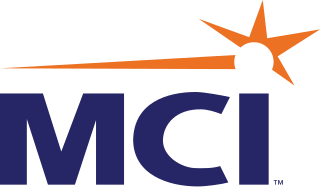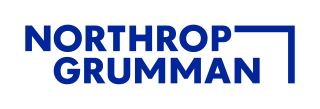
MCI, Inc. was a telecommunications company. For a time, it was the second-largest long-distance telephone company in the United States, after AT&T. WorldCom grew largely by acquiring other telecommunications companies, including MCI Communications in 1998, and filed bankruptcy in 2002 after an accounting scandal, in which several executives, including CEO Bernard Ebbers, were convicted of a scheme to inflate the company's assets. In January 2006, the company, by then renamed MCI, was acquired by Verizon Communications and was later integrated into Verizon Business.
The Lockheed Martin Corporation is an American aerospace, arms, defense, information security, and technology corporation with worldwide interests. It was formed by the merger of Lockheed Corporation with Martin Marietta in March 1995. It is headquartered in North Bethesda, Maryland, in the Washington, D.C. area. As of January 2022, Lockheed Martin employs approximately 115,000 employees worldwide, including about 60,000 engineers and scientists.
BAE Systems plc (BAE) is a British multinational arms, security, and aerospace company based in London, England. It is the largest defence contractor in Europe, and ranked the seventh-largest in the world based on applicable 2021 revenues. As of 2017, it is the biggest manufacturer in Britain. Its largest operations are in the United Kingdom and United States, where its BAE Systems Inc. subsidiary is one of the six largest suppliers to the US Department of Defense. Other major markets include Australia, Canada, Japan, India, Saudi Arabia, Turkey, Qatar, Oman and Sweden, where Saudi Arabia is regularly among its top three sources of revenue. The company was formed on 30 November 1999 by the £7.7 billion purchase of and merger with Marconi Electronic Systems (MES), the defence electronics and naval shipbuilding subsidiary of the General Electric Company plc (GEC), by British Aerospace, an aircraft, munitions and naval systems manufacturer.

Northrop Grumman Corporation is an American multinational aerospace and defense technology company. With 95,000 employees and an annual revenue in excess of $30 billion, it is one of the world's largest weapons manufacturers and military technology providers. The firm ranks No. 101 on the 2022 Fortune 500 list of America's largest corporations.
Leidos, formerly known as Science Applications International Corporation (SAIC), is an American defense, aviation, information technology, and biomedical research company headquartered in Reston, Virginia, that provides scientific, engineering, systems integration, and technical services. Leidos merged with Lockheed Martin's IT sector, Information Systems & Global Solutions, in August 2016 to create the defense industry’s largest IT services provider. The Leidos-Lockheed Martin merger is one of the biggest transactions thus far in the consolidation of a defense sector. Leidos works extensively with the United States Department of Defense, the United States Department of Homeland Security, and the United States Intelligence Community, including the NSA, as well as other U.S. government civil agencies and selected commercial markets.
Loral Corporation was a defense contractor founded in 1948 in New York by William Lorenz and Leon Alpert as Loral Electronics Corporation. The company's name was taken from the first letters of each founder's surname.
United Technologies Corporation (UTC) was an American multinational conglomerate headquartered in Farmington, Connecticut. It researched, developed, and manufactured products in numerous areas, including aircraft engines, aerospace systems, HVAC, elevators and escalators, fire and security, building automation, and industrial products, among others. UTC was also a large military contractor, getting about 10% of its revenue from the U.S. government. Gregory J. Hayes was the CEO and chairman.

CACI International Inc. is an American multinational professional services and information technology company headquartered in Northern Virginia. CACI provides services to many branches of the US federal government including defense, homeland security, intelligence, and healthcare.
Teledyne Technologies Incorporated is an American industrial conglomerate. It was founded in 1960, as Teledyne, Inc., by Henry Singleton and George Kozmetsky.
Harris Corporation was an American technology company, defense contractor, and information technology services provider that produced wireless equipment, tactical radios, electronic systems, night vision equipment and both terrestrial and spaceborne antennas for use in the government, defense and commercial sectors. They specialized in surveillance solutions, microwave weaponry, and electronic warfare. In 2019, it merged with L3 Technologies to form L3Harris Technologies.
EDO Corporation was an American company which was acquired by ITT Corporation in 2007. EDO designed and manufactured products for defense, intelligence, and commercial markets, and provided related engineering and professional services. It employed 4,000 people worldwide and had revenues of $715 million in 2006. EDO's assets went to ITT Defense Electronics and Services. As of May 2015, these assets were now part of Harris Corporation, and since June 2019 L3Harris Technologies.
Herley Industries, based in Lancaster, Pennsylvania, is an American company that specializes in supplying microwave and millimeter wave products to the defense and aerospace industries. They provide solutions for radars, flight instrumentation, weapon sensors, electronic warfare systems, and guidance systems for contractors, the U.S. government, and governments and militaries worldwide.
Parsons Corporation is an American technology-focused defense, intelligence, security, and infrastructure engineering firm headquartered in Centreville, Virginia. The company was founded in 1944.
Stanley, Inc. (NYSE:SXE), acquired by CGI Group in 2010, was an information technology company based in Arlington, Virginia. Founded in 1966 as a small, entrepreneurial consulting company, it evolved into an employee-owned corporation with almost 5,000 full-time employees before being acquired by CGI Group Inc.
The Defence Production Sharing Agreement (DPSA) is a bilateral trade agreement between the United States and Canada that aims to balance the amount of military cross-border buying in order to avoid trade imbalances. Since its signing in 1956, it has led to a number of US companies sending military production to Canada in order to "offset" Canadian purchases of US military equipment. The Agreement has been amended on several occasions. The similar Defense Development Sharing Program organized sharing of military research and development.
Silicon Motion Technology Corporation, stylized as SiliconMotion is an American-Taiwanese company involved in developing NAND flash controller integrated circuits (ICs) for solid-state storage devices. The company said it supplies more NAND flash controllers than any other company, over five billion from 2006 through 2016. They are found in commercial, enterprise, and industrial applications ranging from SSDs, eMMCs, memory cards, and USB flash drives.
Engility Holdings, Inc. was an American publicly traded company that provided engineering and logistics services to several United States Armed Forces and civilian agencies. The company based in Chantilly, Virginia was formed in 2012 as a spin-off of the services division of L3 Technologies. As of 2017, Engility reports an annual revenue of about $2 billion. On September 10, 2018, Science Applications International Corporation announced it was buying Engility for about $2.5 billion with the brand being retired.
L3Harris Technologies, Inc. is an American technology company, defense contractor, and information technology services provider that produces command and control systems and products, wireless equipment, tactical radios, avionics and electronic systems, night vision equipment, and both terrestrial and spaceborne antennas for use in the government, defense, and commercial sectors. They specialize in surveillance solutions, microwave weaponry, and electronic warfare. It was formed from the merger of L3 Technologies and Harris Corporation on June 29, 2019, and was expected to be the sixth-largest defense contractor in the United States.

RTX Corporation is an American multinational aerospace and defense conglomerate headquartered in Arlington, Virginia. It is one of the largest aerospace and defense manufacturers in the world by revenue and market capitalization, as well as one of the largest providers of intelligence services. RTX manufactures aircraft engines, avionics, aerostructures, cybersecurity solutions, guided missiles, air defense systems, satellites, and drones. The company is also a large military contractor, getting a significant portion of its revenue from the U.S. government.



